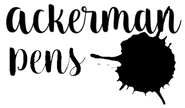About Manga G Nibs
The three most popular Manga G nibs made by Nikko, Tachikawa and Zebra work very well in fountain pens if they are fed ink correctly. This requires a close fit of the ink feed to nib. The sketcher dips the nib in a container of ink to load the nib. Dip nibs are designed to hold ink on the surface using several attractive and cohesive forces, primarily static electricity and surface tension. Gravity pulls the ink down towards the tip when the nib is held in the standard position, so as the sketcher leaves a line of ink on the page, the ink moves down the nib to replace the lost ink. When the ink is gone, the sketcher dips the nib again. The ink channel or slit in a dip nib is cut finely, so the sides of the nib are flush together. The ink runs down the slit only on the surface.
A fountain pen is designed to feed ink to a nib with a specific shape. The curvature of the bottom of the nib must be matched to the top of the ink feed, so no ink leaks out from the side. The channel inside the ink feed must run to the air hole in the nib and no further. The size of the channel must be appropriate for the type of ink that is used - thicker inks need wider channels.
We designed our original ink feed to match the size, shape, and design of the three most popular Manga G nibs made by Nikko, Tachikawa and Zebra. There are slight variations between these nibs, and you can find lots of online discussions about which Manga G nib is best.
When viewed from the side, almost all fountain pen nibs run straight across the top or spine of the nib from the back to the front of the nib. Manga G nibs tend to dip at the tip.
The dip provides extra spring at the tip, but it only provides a problem when used as a fountain pen nib. Because of the dip, it is not possible to bring the point of the underfeed close to the tip of the nib where it should be. If the feed extends near the tip, the rest of the nib rides up on the feed, which reduces the flow of ink from the feed to the nib. The underfeed has to stop short of the dip, which reduces the flow of ink to the tip. After all, no ink is flowing up the channel.,/p>
A good addition is an overfeed device. The overfeed delivers ink to the top from the top, and bends back out of the way when the nib flexes. It is not possible to straighten the tip of the Zebra Manga G without jeopardizing the spring of the tip and threaten the performance of the nib.
The best solution we offer is our Manga G with Overfeed Pump Pen that includes a Manga G nib with the modified V-shaped ink channel.
We offer a variety of pens that let you use Manga G nibs: Fountain Pens, Pump Pens, and Demonstrators. We carry three Manga G nib manufactures: Nikko, Tachikawa, and Zebra.
Nikko G Nib
- The least expensive G nib
- Medium flex
- Smooth — no scratchiness
- Recommended by Michael Full
Tachikawa G Nib
- More expensive than the Nikko but less than the Zebra
- Finer hair lines
- More flexible than the Nikko G
- Hard to start for some people
- Some nibs are coated with oil, removed with rubbing alcohol, or passing the nib through a flame
- Recommended by Connie Chen
Zebra G Nib
- Produces the finest hairlines because it has the sharpest tip
- The difference between hairline and swell requires more pressure
Titanium Zebra G Nib
- Twice as expensive as the Zebra but lasts much longer
- Titanium-coated to last longer
- More flexible than standard Nikko but produces thicker hairlines
Connie Chen provides a YouTube video Calligraphy Nib Review: G Nibs illustrating comparisons of each G nib.
Related article: Using Manga G Nibs as Fountain Pen Nibs
